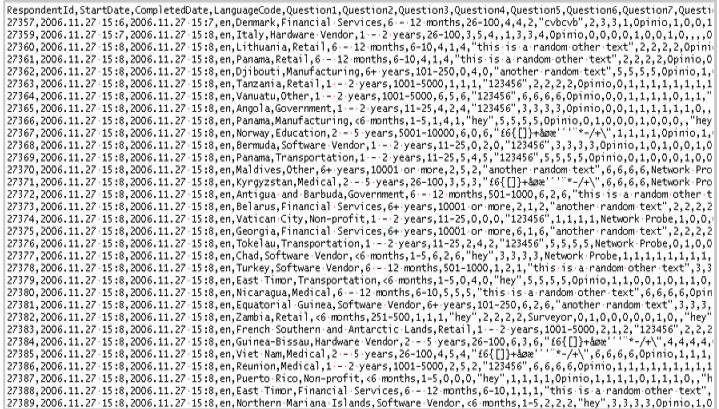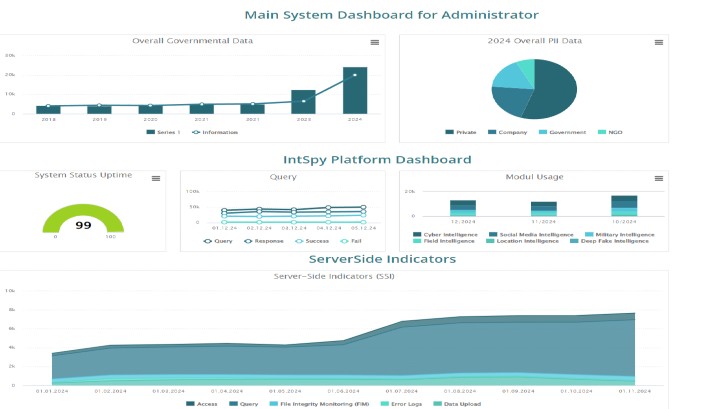Cyber Intellıgence
IntSpy Cyber Intelligence: Collect, Analyze, and Counteract – Comprehensive Intelligence for Offensive and Defensive Operations.



[MODULE]Cyber Intelligence on platform
Cyber Intelligence Overview
IntSpy’s Cyber Intelligence module serves as an advanced digital intelligence solution that offers comprehensive cyber threat monitoring and actionable intelligence gathering. It not only helps organizations detect, analyze, and mitigate cyber threats but also provides tools to gather information on adversaries, predict hostile activities, and exploit vulnerabilities strategically. By leveraging both defensive and offensive capabilities, IntSpy empowers users to stay ahead of their opponents in the ever-evolving cyber landscape.
Sub-Modules of Cyber Intelligence
-
IP Address Intelligence
- IP Blacklist Check: Determines if an IP address is listed on known blacklists, which is useful for identifying potentially compromised or malicious IPs that adversaries may use. By proactively monitoring enemy infrastructure, users can predict attack sources and disrupt their plans.
- IP Whois Search: Provides ownership and registration details about IP addresses. This is crucial for tracing hostile actors, mapping their network infrastructure, and understanding their operational reach.
- IP to Location: Identifies the geographic location of an IP address, providing critical information about the origin of network activity. It allows users to understand where enemy infrastructure is based, track the physical location of malicious actors, and gather intelligence on potential adversary hubs or operational bases.
- Continuous IP Monitoring: This sub-module provides real-time and continuous monitoring of specific IP addresses of interest. It tracks changes in their status, geographic location, network activity, and any movement onto blacklists. Continuous monitoring is crucial for maintaining up-to-date intelligence on adversary infrastructure and enables proactive threat detection and response.
-
Network Monitoring and External Attack Surface Management
- Network Continuous Monitoring: Constantly monitors the network environment, including known adversary networks and your own organization’s infrastructure, to identify any unusual or suspicious activity. This includes scanning for unauthorized access, traffic anomalies, and threats to the network’s stability. The module allows security teams to stay one step ahead by acting as an early warning system for network-based attacks.
- External Attack Surface Monitoring: Provides an overview of all external digital assets, including domains, IP addresses, web services, and other internet-facing components. It scans for vulnerabilities, weak spots, and publicly exposed data to identify potential entry points for adversaries. By continuously scanning and monitoring the external attack surface, organizations can mitigate risks before adversaries exploit them, ensuring proactive defense of their infrastructure.
-
Deep Fake Detection and Manipulation Analysis
- Deep Fake Reports: Generates in-depth reports on deep fake content, analyzing audio, video, and images to detect manipulation. It can be used offensively to verify information used by adversaries or to discredit propaganda efforts.
- Audio Detection: Detects altered or synthesized audio, allowing users to verify the authenticity of intercepted communications.
- Video and Image Detection: Analyzes visual media for manipulation, aiding in the verification of intelligence collected about opponents, ensuring authenticity before actions are taken.
-
Image Meta Data Analysis
- This sub-module extracts metadata from images to gain insights into the origins, location, and context of a captured image. It can be used to identify where and when images were captured by adversaries, aiding in tracing their movements and operational capabilities.
-
Dark Web Intelligence
- Darkweb Search: Searches the dark web for sensitive information related to specific targets, including data breaches, stolen credentials, and enemy activities. This module allows users to monitor for leaked intelligence, identify hostile actors, and even gather information about enemy operations before they unfold.
-
Threat Intelligence and Hostile Actor Mapping
- Threatmap: A real-time global map that shows ongoing cyber activities, helping users visualize the geographic distribution of attacks and understand areas where adversaries are most active.
- Alarms: Sends real-time alerts for cyber threats by monitoring various data sources. These alarms can help users detect enemy actions early, offering an opportunity to counteract them before damage occurs.
-
Domain Intelligence
- Domain Whois Search: Provides ownership and registration information for domains. This sub-module is instrumental in mapping adversaries’ online infrastructure, tracing connections between various domains, and uncovering networks used for command and control operations.
- Data Vulnerabilities: Analyzes vulnerabilities in enemy domains, helping to identify potential attack vectors that could be exploited for offensive operations. By understanding their weaknesses, users can determine the most effective methods for disabling or exploiting adversary systems.
-
Vulnerability and News Monitoring
- Vulnerability News: Keeps users informed about the latest vulnerabilities, allowing proactive action against adversaries who may be exposed. Users can take advantage of known vulnerabilities before they are patched by enemy operators.
- Data Vulnerabilities: Analyzes weaknesses within adversary digital assets, offering opportunities for exploitation. This module is essential for gathering offensive intelligence and planning strategic interventions.
-
External Data Source Integration
- Add External Data Sources: This feature allows users to integrate third-party external data sources into the Cyber Intelligence module. Users can add feeds from threat intelligence providers, open-source threat databases, or any other relevant external data to enhance the depth and breadth of their intelligence capabilities. This flexibility ensures that the platform remains adaptable to each organization’s unique intelligence needs.
-
Third-Party Tool Integration
- Custom Integration of Third-Party Tools: IntSpy provides the ability to integrate with third-party cybersecurity tools based on specific user requirements. Whether it is integrating advanced vulnerability scanning tools, SIEM (Security Information and Event Management) systems, or automated penetration testing platforms, users can customize the platform to meet their specific operational goals. This modular approach ensures that each organization’s existing infrastructure can be enhanced and leveraged effectively through seamless integration.
Use Cases and Applications
- Offensive Cyber Operations: The Domain Intelligence and Data Vulnerabilities sub-modules provide the tools to identify and exploit weaknesses in adversary networks. The Threatmap and Alarms modules can pinpoint enemy activities in real time, helping operators prepare countermeasures or proactive strikes.
- Continuous Threat Monitoring: Continuous IP and Network Monitoring provides real-time insights into any suspicious activity involving IP addresses or networks of interest, offering early alerts to prevent threats before they escalate.
- External Attack Surface Reduction: External Attack Surface Monitoring helps organizations minimize their risk by identifying and mitigating vulnerabilities in exposed assets before they can be targeted by adversaries.
- Customized Intelligence Expansion: The Add External Data Sources capability ensures that organizations can expand the intelligence gathered by incorporating external data feeds, giving them the flexibility to cover additional threats and stay up-to-date with global threat trends.
- Tailored Tool Integration: The Third-Party Tool Integration feature allows users to enhance the Cyber Intelligence module with existing tools, ensuring a more robust and customized approach to threat detection, analysis, and response.
- Enemy Activity Monitoring: The Dark Web Intelligence module allows users to monitor adversary communications and potential leaks, providing early warning of hostile operations and insight into enemy plans.
- Geographic Tracking of Threats: The IP to Location sub-module helps users understand the physical locations of enemy infrastructure and cyber actors. By pinpointing the geographical origin of malicious activities, users can make informed decisions for targeting, neutralizing threats, and formulating defensive measures.
- PsyOps and Propaganda Counteraction: Deep Fake Detection modules help identify and counter enemy propaganda efforts. Deep fake analysis ensures that hostile misinformation is exposed, enabling proactive countermeasures to maintain strategic advantage.
Key Benefits of the Cyber Intelligence Module
- Comprehensive Defense and Offensive Capabilities: Offers a unique mix of defensive and offensive tools, from identifying vulnerabilities to proactively exploiting weaknesses in enemy networks.
- Continuous Visibility and Threat Detection: Continuous IP and network monitoring ensures that any suspicious activity is detected immediately, allowing for proactive responses to threats.
- Advanced Threat Identification: Uses AI to detect emerging threats from adversaries, analyze their digital footprint, and gather critical intelligence about their intentions and capabilities.
- External Threat Protection: External Attack Surface Monitoring helps users continuously assess and secure their internet-facing assets, reducing the risk of successful adversary exploitation.
- Flexibility with External Data Integration: The ability to add external data sources ensures that users can stay informed about global threats by incorporating third-party threat feeds and data sources.
- Customizability through Third-Party Tools: Users can integrate third-party cybersecurity tools into the platform, creating a personalized approach to cyber intelligence that leverages their existing capabilities.
- Real-Time Visibility of Adversary Actions: Provides users with the ability to visualize and track adversary movements and operations through Threatmap and IP to Location, ensuring they stay one step ahead.
- Strategic Decision-Making Support: Detailed reports and vulnerability analyses allow users to make informed decisions when planning operations against adversaries or securing their own infrastructure.
Integration and Usability
- The Cyber Intelligence module integrates seamlessly into the IntSpy platform, enabling users to leverage other intelligence capabilities such as Field Intelligence and Military Intelligence for more comprehensive situational awareness.
- Offensive and defensive insights can be further expanded by using Location Intelligence to verify on-ground movements of targets and assess their geographic presence through IP to Location data.
- Continuous Monitoring tools, including IP and Network Monitoring and External Attack Surface Monitoring, provide always-on insights and alerts, enhancing both defensive resilience and offensive situational awareness.
- The platform’s flexible architecture allows users to add external data sources and integrate third-party cybersecurity tools, making it a highly adaptable solution that evolves with user needs.
- The platform’s intuitive dashboard makes it easy to switch between modules and correlate intelligence from different sources, supporting both strategic offensive planning and robust defensive measures.
